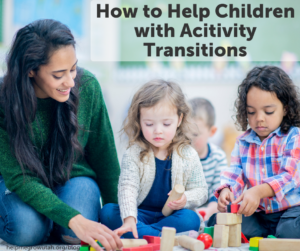 Transitioning from one activity to another can be challenging for adults and children. Being told “it’s time to go” out of nowhere can make adults scramble to finish up last-minute items we forgot to do. For a child, it’s no different. We might not see it from their perspective, especially when the activity is fun and engaging. Children are prone to having a more challenging time transitioning, but it doesn’t have to be a huge ordeal. Below are some transitioning tips for children.
Transitioning from one activity to another can be challenging for adults and children. Being told “it’s time to go” out of nowhere can make adults scramble to finish up last-minute items we forgot to do. For a child, it’s no different. We might not see it from their perspective, especially when the activity is fun and engaging. Children are prone to having a more challenging time transitioning, but it doesn’t have to be a huge ordeal. Below are some transitioning tips for children.
Visual or Verbal Reminder
Have a visual or verbal transitional item in place. It can be a timer on an app. It can also be the illustrations incorporated in this post. Remember to remind the child about the minutes constantly left so they are not surprised or overwhelmed by the sudden need to leave the park or stop watching their favorite show. You may find yourself continually repeating like a parrot, but children need repetition to master skills like transitioning.
Establish Routines
Try to establish a routine. Routines can be complicated when school schedules, jobs, and health issues are inconsistent. Regular schedules can help children because they know what will happen throughout the day. When able to create a plan, your child can get used to or understand it. For example, washing hands before and after dinner. At night brushing teeth after bath time but before bed. Anything you can pair to help your child know the order of activities.
Praise
Praise, Praise, Praise!! There will be moments when your child listens to you and transitions quickly. There will also be moments when they become more independent and don’t want to transition. The power of positive attention can change behavior. According to the Child Mind Institute, positive attention requires a “lens shift in which we call out kids for good behavior and ignore (at least in the moment) the not-so-good.
The idea is that for children, parental attention is so powerful that whatever behavior we pay attention to will increase, even if we’re telling them to stop.” Keep sticking with it. Praise will bring about the changes you wish to see, much sooner than criticism will.
Involve the child
To help influence your child, you must try connecting with them. Try to see transitions from your child’s point of view—practice role-playing. When possible, ask your child for their opinion. What would help them change? Is it bringing a toy with them to the car? Work together to figure out what you can do. How can we make both parent and child happy?
As a school teacher, I remember constantly coming up with ways to help preschoolers transition. Whether it was using the buddy system, penny board and earning a snack, the timer on the board, or losing my voice from constant reminders, helping the child transition was more important than me losing my patience or getting my way. Some children need extra encouragement. Remember, they are just children; their emotional maturity is still growing. They are not trying to make you late, mad, or cause problems. You have shown them how fun the world can be; it’s hard for them to stop.
Additional Resource: How to Help Children with Transitions





